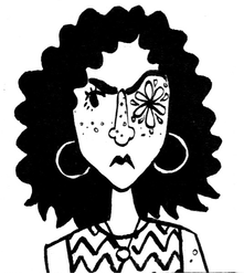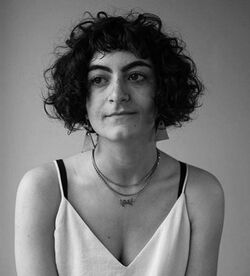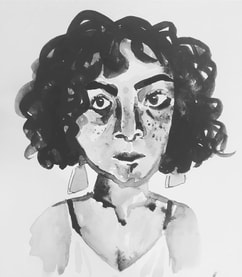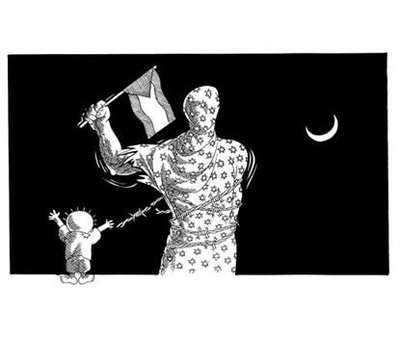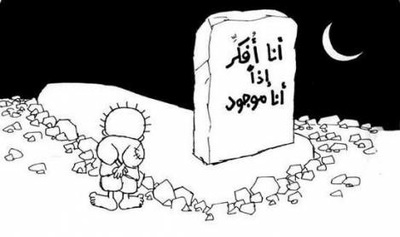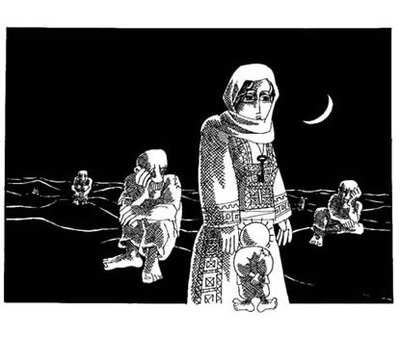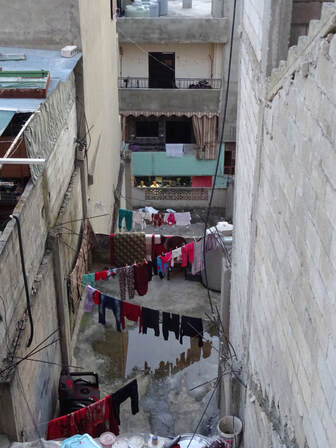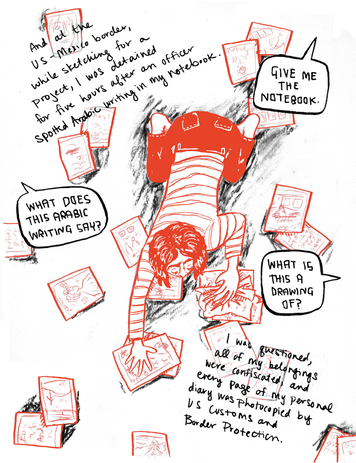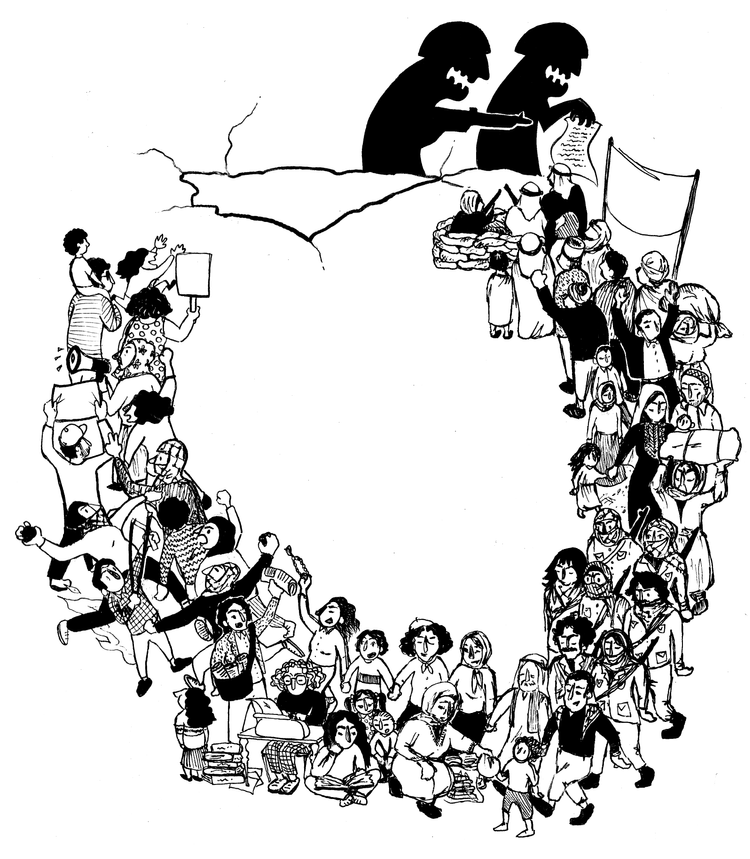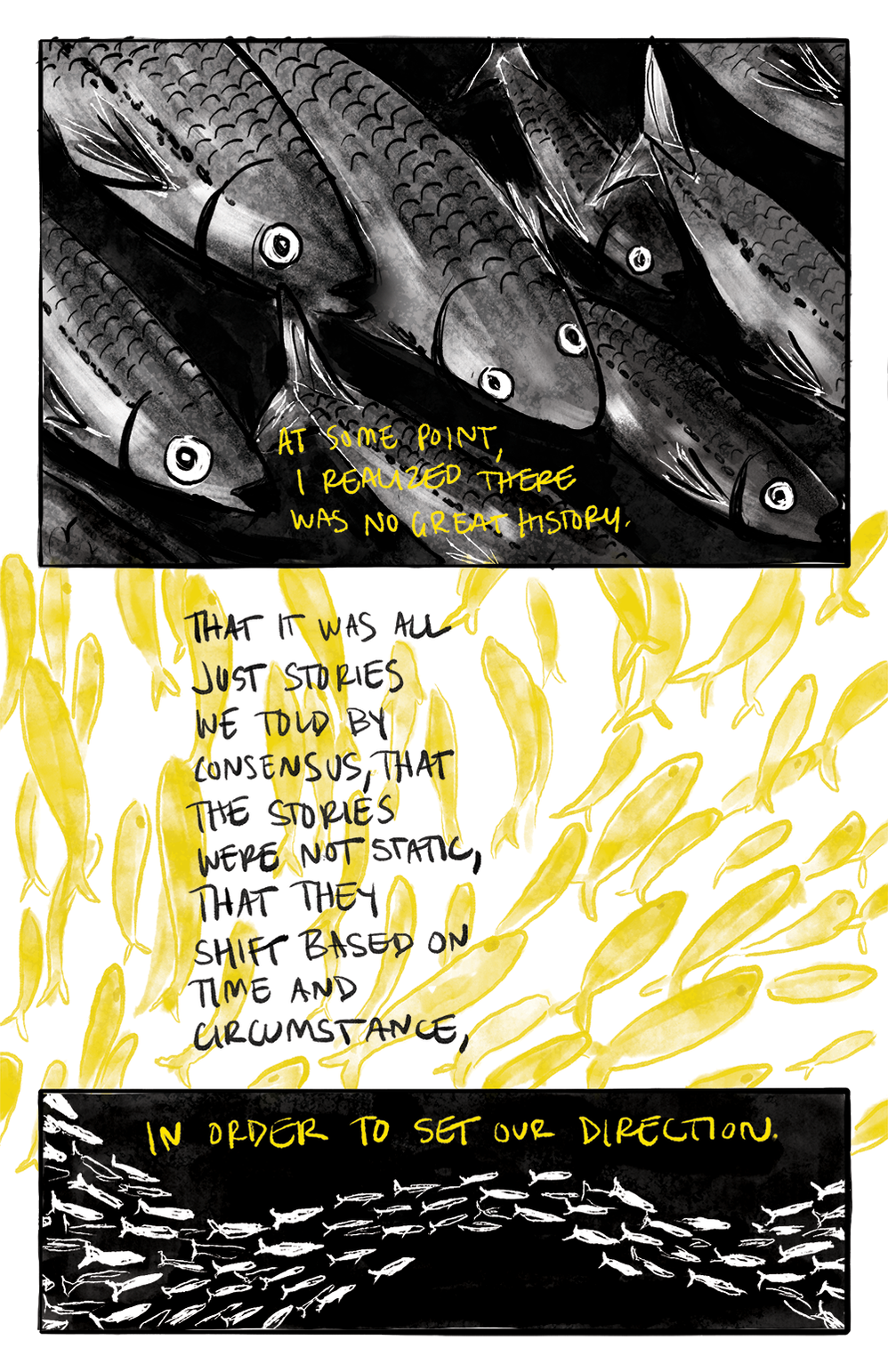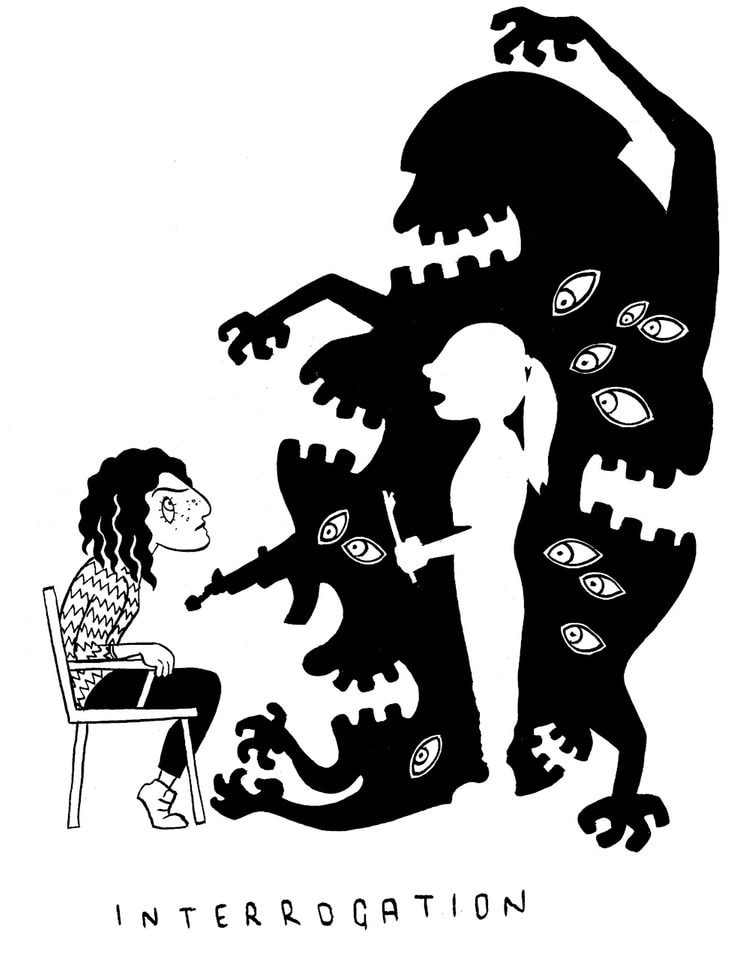- Home
- About
- Contact
-
Sections
- History & Background >
- Emergent, Experimental, and Online Comix >
- Ongoing Serials (in English)
-
Existing & Forthcoming Titles (in English)
>
- Ahmed Naji, Using Life
- Ganzeer: The Solar Grid
- Hamid Sulaiman, Freedom Hospital
- Leila Abdelrazak, Baddawi
- Lena Merhej, Jam and Yogurt
- Lina Ghabeih, An Education in Fear
- Magdy el Shafee, Metro
- Muqtatafat
- Riad Sattouf, Arab of the Future
- Tarek Shahin, Rise
- The 99
- Zeina Abirached, A Game for Swallows and I Remember Beirut
- Selected Writers & Artists >
- Cultural & Political Context >
ABOUT LEILA ABDELRAZAQ
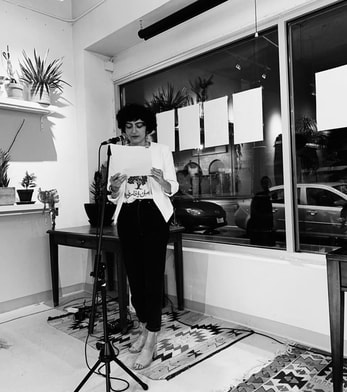
Leila Abdelrazaq is a Palestinian author, artist, and organizer. She was born and raised in Chicago, Illinois. Abdelrazaq has always been interested in art and began drawing when she was a child (Sawyer). She is currently based out of Detroit, Michigan (“Leila Abdelrazaq.” Praxis).
Abdelrazaq graduated from DePaul University in Chicago in 2015 with a BFA in Theatre Arts and a BA in Arabic Studies (Abdelrazaq, “CV”). While attending DePaul, Abdelrazaq served as a member of the Students for Justice in Palestine Committee (“Leila Abdelrazaq.” Pen). Currently, she is working towards her MA in Modern Middle Eastern and North African Studies at the University of Michigan, her research is focused on issues related to iconography in Arab art, media, and cultural production (Abdelrazaq, “Artist”). She is expected to graduate in 2020 (Abdelrazaq, “CV”).
Abdelrazaq’s work primarily focuses on issues that impact her life such as: diaspora, refugee experience, history, memory, and borders (Abdelrazaq, “Artist”). While studying at DePaul Abdelrazaq became “frustrated how white all of the stories were” and decided to start creating her own comics. In 2015, Abdelrazaq’s big debut came with the publication of her first graphic novel, Baddawi through the publishing company, Just World Books. Baddawi originally started as a web comic series during Abdelrazaq’s first year as an undergraduate student at DePaul. It was through connections she made while working as an organizer at Free Justice for Palestine that got this comic series into the hands of a publisher at Just World Books (Sawyer). To date, Baddawi has been translated into three languages: Korean (Hudd Books 2016), Arabic (Kalimat Group 2017), and French (Steinkis Editions 2018). Abdelrazaq is also the author and illustrator of The Opening published by Tosh Fest in 2017 (Abdelrazaq, “CV”).
Aside from her book publications, Abdelrazaq’s artistry extends far and wide into zines, comix, illustration, printmaking, and animation. Abdelrazaq is the illustrator for The Specimen’s Apology by George Abraham published by the Sibling Rivalry Press in 2019 (Abdelrazaq, “CV”). Numerous comics and illustrations, mostly centered around activist issues, can be found in magazines and internet blogs. Abdelrazaq has also created an animated comic titled Still Born. This animation is based on an essay written in 2002 by her mother, Sandra Young titled “How To Be The Mother of a Stillborn Baby” (Abdelrazaq, “Animation”).
Though she is still an emerging artist and author, her efforts have not gone unnoticed. In 2015, Baddawi was shortlisted for the Palestine Book Awards. In 2018, her animation Still Born was a finalist for the Young Artist of the Year Award by the A. M. Quattan Foundation (Abdelrazaq, “CV”).
Aside from her work as an author and artist, Abdelrazaq is one of three co-founders of the publishing company, Maamoul Press.
Abdelrazaq graduated from DePaul University in Chicago in 2015 with a BFA in Theatre Arts and a BA in Arabic Studies (Abdelrazaq, “CV”). While attending DePaul, Abdelrazaq served as a member of the Students for Justice in Palestine Committee (“Leila Abdelrazaq.” Pen). Currently, she is working towards her MA in Modern Middle Eastern and North African Studies at the University of Michigan, her research is focused on issues related to iconography in Arab art, media, and cultural production (Abdelrazaq, “Artist”). She is expected to graduate in 2020 (Abdelrazaq, “CV”).
Abdelrazaq’s work primarily focuses on issues that impact her life such as: diaspora, refugee experience, history, memory, and borders (Abdelrazaq, “Artist”). While studying at DePaul Abdelrazaq became “frustrated how white all of the stories were” and decided to start creating her own comics. In 2015, Abdelrazaq’s big debut came with the publication of her first graphic novel, Baddawi through the publishing company, Just World Books. Baddawi originally started as a web comic series during Abdelrazaq’s first year as an undergraduate student at DePaul. It was through connections she made while working as an organizer at Free Justice for Palestine that got this comic series into the hands of a publisher at Just World Books (Sawyer). To date, Baddawi has been translated into three languages: Korean (Hudd Books 2016), Arabic (Kalimat Group 2017), and French (Steinkis Editions 2018). Abdelrazaq is also the author and illustrator of The Opening published by Tosh Fest in 2017 (Abdelrazaq, “CV”).
Aside from her book publications, Abdelrazaq’s artistry extends far and wide into zines, comix, illustration, printmaking, and animation. Abdelrazaq is the illustrator for The Specimen’s Apology by George Abraham published by the Sibling Rivalry Press in 2019 (Abdelrazaq, “CV”). Numerous comics and illustrations, mostly centered around activist issues, can be found in magazines and internet blogs. Abdelrazaq has also created an animated comic titled Still Born. This animation is based on an essay written in 2002 by her mother, Sandra Young titled “How To Be The Mother of a Stillborn Baby” (Abdelrazaq, “Animation”).
Though she is still an emerging artist and author, her efforts have not gone unnoticed. In 2015, Baddawi was shortlisted for the Palestine Book Awards. In 2018, her animation Still Born was a finalist for the Young Artist of the Year Award by the A. M. Quattan Foundation (Abdelrazaq, “CV”).
Aside from her work as an author and artist, Abdelrazaq is one of three co-founders of the publishing company, Maamoul Press.
“I am dedicated to creating unapologetically political work that defies simple sloganeering, sparking necessary critical conversations in the Palestinian community.” (Abdelrazaq,”Artist Statement”)
MAAMOUL PRESS
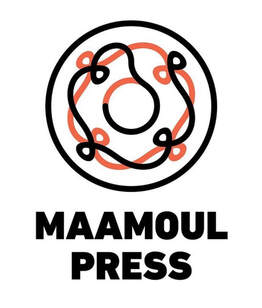
In February of 2019, Maamoul Press was founded by Leila Abdelrazaq, Aya Krisht, and Zeinab Saab. Aya Krisht is a Lebanese graphic designer and printmaker who is based out of Dearborn, MI. She currently works as the Media Designer at the Arab American National Museum (Krisht). Zeinab Saab is a printmaker from Detroit, MI (Rupersburg). Saab’s work is currently focused on what it is like to live within a multiplicity of cultures as someone who has intersecting identities (Saab).
The idea for the press came from Abdelrazaq with a blog she had started in 2016 called “Bigmouth Press & Comix”. In its beginning, Bigmouth was a blog for Middle Eastern women artists and authors to profile their work. Eventually, it evolved into distributing and publishing for those women artists who were featured on the blog. Abdelrazaq became interested in this aspect of the site she had created and contacted Krisht about working together to form what is now the Maamoul Press (Rupersburg).
The Maamoul Press is a “multi-disciplinary small press and collective” created by artists for artists. Specifically, it was created by three artists who personally know the struggles of being from communities whose voices often go unheard. The press is designed to help artists from diverse and marginalized communities have their work displayed and published. The ethos of the press is written as, “Storytelling for us, by us. Forging the arts spaces we need. Generating knowledge through community” (“About”). The press aims to change the narrative about the stories of their communities, by having these stories come from their voices as opposed to the voices of those on the outside looking in. It has also created a space for art and stories to be shared that had no place previously. In this way, they work to fight various forms of oppression that keep people in the marginalized parts of society. The press also helps to mentor and guide new, emerging artists, especially those who have had no formal training to help them with the transition in having their work viewed and published (“Our Ethos”).
Currently the press is home to twenty-one artists excluding its founders. Their website features a book shop that holds fourteen books published by Maamoul as well as a variety of prints by different artists (“Bookshop”).
The idea for the press came from Abdelrazaq with a blog she had started in 2016 called “Bigmouth Press & Comix”. In its beginning, Bigmouth was a blog for Middle Eastern women artists and authors to profile their work. Eventually, it evolved into distributing and publishing for those women artists who were featured on the blog. Abdelrazaq became interested in this aspect of the site she had created and contacted Krisht about working together to form what is now the Maamoul Press (Rupersburg).
The Maamoul Press is a “multi-disciplinary small press and collective” created by artists for artists. Specifically, it was created by three artists who personally know the struggles of being from communities whose voices often go unheard. The press is designed to help artists from diverse and marginalized communities have their work displayed and published. The ethos of the press is written as, “Storytelling for us, by us. Forging the arts spaces we need. Generating knowledge through community” (“About”). The press aims to change the narrative about the stories of their communities, by having these stories come from their voices as opposed to the voices of those on the outside looking in. It has also created a space for art and stories to be shared that had no place previously. In this way, they work to fight various forms of oppression that keep people in the marginalized parts of society. The press also helps to mentor and guide new, emerging artists, especially those who have had no formal training to help them with the transition in having their work viewed and published (“Our Ethos”).
Currently the press is home to twenty-one artists excluding its founders. Their website features a book shop that holds fourteen books published by Maamoul as well as a variety of prints by different artists (“Bookshop”).
BADDAWI
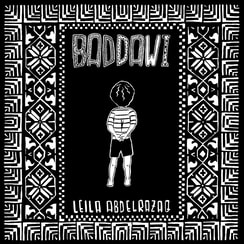
By telling the story of her family, Leila Abdelrazaq also tells the story that myriad other Israeli refugees experienced during Nakba – the removal of Palestinians from Israel during 1948 (Baddawi 11). Although the graphic novel's contents and story are specific to the upbringing of her father, it touches upon the violence and inconsistency that refugees experienced. Through her graphic novel, Baddawi, Abdelrazaq divulges a perspective of Palestinians that people would otherwise be unexposed to. Teaching readers of traditional and cultural aspects of Palestinians along the way in addition to the struggles that they face. Abdelrazaq's Baddawi also received the Shortlist Award for the 2015 Palestine Book Awards (LALALEILA).
TATREEZ IN BADDAWI
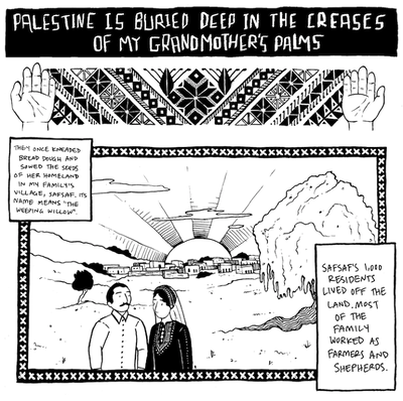
Throughout Abdelrazaq's Baddawi, a variety of geometric, floral, and sometimes "pixelated"-looking patterns are integrated into her illustrations, such patterns and designs are commonly used in traditional Palestinian embroidery, known as tatreez (Baddawi 13). Abdelrazaq's repeated use of tatreez in Baddawi reflects the main message of her graphic novel: to share the cultural aspects, and narratives of Palestinians, those which are presently being systematically removed from mainstream media (Khoury 10:03). The bold, beautiful designs are visually appealing, as well as an integral part of Palestinian culture that’s virtually unknown westerners. By including tatreez in Baddawi, Abdelrazaq enables her audience to establish a connection––and appreciation––for Palestinian artistry in ways that they (likely) wouldn’t otherwise.
Photo Credit: http://lalaleila.com/
THE SYMBOLIC COVER OF BADDAWI:
HANDALA & AHMAD

Naji al-Ali created Handala, a cartoon character, during the 1970’s, as a way to portray the little control that Palestinians had over the events happening in their lives. Handala was a ten-year-old boy who had his back to the public, and his hands clasped behind him, who helplessly watched the political events around him unfold (Baddawi 11). He was to turn around and show the world his face once Palestinians were free and could return home, but that never happened, as Naji al-Ali was assassinated before Palestinians were free (Baddawi 11). Although Naji al-Ali died before Handala could turn around he still played a role within society by becoming a significant symbol to the efforts of Palestinian resistance. And like Handala, Ahmad’s story is that of a Palestinian refugee child, who cannot do much but watch the events around him unfold. And to solidify the connection and similarities between Handala and Ahmad, Abdelrazaq features Ahmad standing in the same manner as Handala on the cover of Baddawi. Making her novel a part of the resistance movement, not only by speaking up and telling a story that others suppress, but by connecting it to a well-known resistance symbol. For more information on Naji al-Ali and Handala, please visit www.handala.org.
Photo Gallery Credit: http://www.handala.org
COMING-OF-AGE: REFUGEE OR NOT,
SIMILAR CHALLENGES
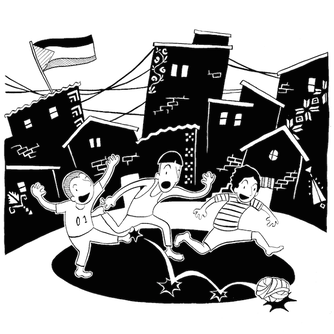
While the political circumstances of Ahmad's youth may differ from many other children internationally, the challenges and experiences of his daily life are the same (Baddawi 25). Ahmad is excluded from playing with others for not having the "right" cleats, disobeys his mother, and has a crush on a girl--all aspects of adolescence that are relatable to people of all nationalities (Baddawi 25, 31, 52, 92). In Abdelrazaq's Baddawi, her main target audience is westerners, primarily for their lack of awareness of what it truly means to be Palestinian: "born into a life of exile and persecution, indefinately suspended in statelessness" (Baddawi 12). Rather than allowing westerners to deem Palestinians as unworthy of recognition, Abdelrazaq uses Ahmad's personal accounts which allows her audience to establish a connection that will help them better understand the life of Palestinians. The more the audience relates to Ahmad, they more likely they are to develop a more empathetic approach when considering the political circumstances surrounding Palestinian refugees.
BADDAWI REFUGEE CAMP
|
Baddawi is not only the title of the book, but the name of one of the refugee camps that Ahmad resided in, located in Tripoli, Lebanon. The refugee camp was established during 1955 and has been the home to many Palestinian refugees since then (Fiddian-Qasmiyeh 2018). However, over time it has expanded and not only grown in size but in diversity as well; and is now home to Palestinian, Syrian, Iraqi, and Kurd refugees. The camp seems to keep expanding to compensate for the incoming refugees, and because of the lack of space can only construct vertically (Fiddian-Qasmiyeh 2018). It is the culmination of towering buildings and small alley ways decorated with power lines and clothing lines. And although many refugees desire to return home they have brought their traditions and culture to the camp and try to live in normality. Camps were and are a big part of refugee’s lives and had an impact on Ahmad as well. Life in refugee camps are shown within the graphic novel and are an essential part in understanding the lives of refugees.
|
SAFSAF, PALESTINE: THE VILLAGE OF ABDELRAZAQ'S FAMILY
The slideshow above includes a collection of images, courtesy of Palestineremebered.com, which displays of the misfortune that Safsaf, Palestine has been forced to endure. The first six (black and white) images serve as a record of the terror that was inflicted on the village of Safsaf––as described in Baddawi––during the massacre of its residents (many of which worked as farmers and shepherds) on October 31, 1948 (Palestine Remembered). The following three (color) images were taken in 1999 and present what little ruins are left of Safsaf (Palestine Remembered). By recognizing the circumstances at hand, and taking note of the history behind the continuous political turmoil of Palestinians internationally, we can slowly work towards aiding them in receiving the justice they so rightfully deserve.
"The site is overgrown with grass and scattered trees among which can be seen a few terraces and piles of stones from destroyed houses. A few houses are inhabited by Israelis"
--Palestinian historian Walid Khalidi (Palestine Remembered)
--Palestinian historian Walid Khalidi (Palestine Remembered)
Photo Credit: http://lalaleila.com/
THE OPENING
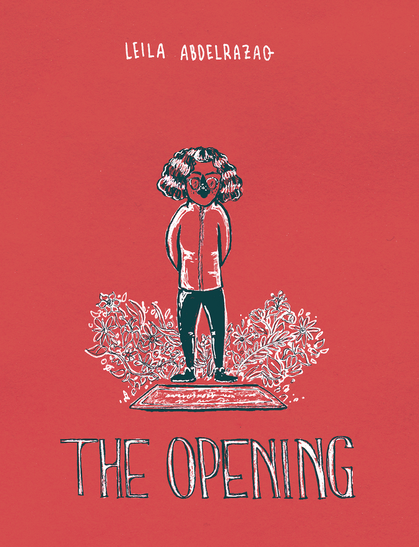
Leila Abdelrazaq’s second book titled The Opening was published under Tosh Fresh in 2017. The Opening engages with themes of loss, absence, memory, imagination, religion, diaspora, and return (“Leila Abdelrazaq”). It is a short comic at only 27 pages. This story is much like Baddawi in that it is a telling of a story that is personal to Abdelrazaq, this one being almost an autobiography. The plot of the story is a young girl, identical to Leila, as the main character, a young Palestinian-American in Chicago, dealing with the loss of her sister, as she was a stillborn. Abdelrazaq presents us with a story of loss, but also an imagined life with her sister. It is heartbreaking yet has an element of hopefulness to it. She also presents us with the different ways she as a young child handles the grief unlike her parents. While reading this short comic I could really feel the different ways that she was handling the grief and how she didn’t really identify with how her parents dealt with it. She imagined playful situations with her sister and had a hopeful attitude such as her sister still having some sort of divine presence in her life. She could see her parents living with their sadness of the situation, but she very much presents the reader with that outsider perspective a child feels when their parent is grieving.
She also highlights the fact that her ancestors are from the village called Safsaf. Which she writes “was known for its white figs and natural spring” (Abdelrazaq, 8). There is an allusion between the two subjects of her sister who was a stillborn and the beautiful home she has only heard of. There is a sense of loss and loss of identity in this book, as the young girl feels attached to her sister, Hana, only to never experience a life with her. And to further elaborate on these themes she is also a victim of diaspora, where she feels the loss of a home she has never experienced, Palestine. Leila Abdelrazaq tells the heartbreaking true story of loss and grief in this book, and while it is a sensitive subject, unfortunately it is a reality that many experience which she able to tackle.
She also highlights the fact that her ancestors are from the village called Safsaf. Which she writes “was known for its white figs and natural spring” (Abdelrazaq, 8). There is an allusion between the two subjects of her sister who was a stillborn and the beautiful home she has only heard of. There is a sense of loss and loss of identity in this book, as the young girl feels attached to her sister, Hana, only to never experience a life with her. And to further elaborate on these themes she is also a victim of diaspora, where she feels the loss of a home she has never experienced, Palestine. Leila Abdelrazaq tells the heartbreaking true story of loss and grief in this book, and while it is a sensitive subject, unfortunately it is a reality that many experience which she able to tackle.
ZINES & COMICS
|
Leila Abdelrazaq has also published many single strip comix as well as zines, all of which include a strong political presence. While her two published works rely heavily on the influence of the Palestinian-Israeli conflict and focus on more individual stories, her single strip comics focus on a struggle that is all too real for many people struggling with displacement due to political reasons. While most of her works highlight the struggle of diaspora, she also uses her platform to bring attention to the intense political turmoil here in America. In her comic Border Diary, she focuses the topic on the intensive interrogation experienced by many while crossing any countries border. She has struggled with this not only when trying to visit her home, but also at the United States/Mexico border. She writes in the comic that she was detained at the US-Mexico border for five hours because she had Arabic writing visible, an act that is unquestionably dehumanizing. This specific comic not only specifies her story while crossing the border, but she has a way of blatantly expressing the grievances that so many Palestinians face. Her narrative in this comic is charged and unapologetic. Abdelrazaq has a creative way of crafting her works so that they force the reader to (maybe at a surface level) understand the harsh realities that she and so many others face.
|
Image credits: https://lalaleila.com/
STILL BORN
|
Still Born from Leila Abdelrazaq on Vimeo. |
|
Abdelrazaq has also created an animated video which is a heartbreaking telling of a mother experiencing a stillbirth, based on her own mother’s essay, “How To Be The Mother of a Stillborn Baby”. In the video she highlights the struggle of grief that her mother has felt as a result of losing a child. It is a difficult subject to talk about, but she doesn’t shy around bringing up the harsh reality she and so many others have lived. This video could also be interpreted as a metaphor for the struggle that her and many others face as the result of being displaced. Most of her other illustrations and animations feature the grief and struggle of loss. It may be harder to identify with the loss of a nation as she has experienced, but by utilizing this story of her mother’s it emphasizes the same emotional feelings of sadness and loss of identity brought up. Like her other works, she uses mostly black and white drawings with the occasional spritz of bright color so as to emphasize the subject or topic.
|
COMICS, CULTURE, & SOCIETY LECTURE
Leila Abdelrazaq gives a talk about her writing/creating process at the University of Illinois at Chicago. She mentions the importance of telling her own story and the different aspects that she purposely included in Baddawi.
RECOGNIZING & HONORING
PALESTINIAN VOICES
|
In an interview with Palestine Studies TV host, Khelil Bouarrouj, Leila Abdelrazaq reveals how Baddawi progressed from a blog-based web series, into a critically acclaimed, full-length graphic novel. Abdelrazaq reiterates the importance of sharing a multitude of Palestinian stories and history, those which are often left unrecognized in the Western world. The story of Abdelrazq's father, Ahmad, is representative of the (over five million) refugees that have been impacted by the Palestinian diaspora, and speaks for the dire need of international recognition for their uncontrollable circumstances (Baddawi 11). While Palestinians have yet been
|
|
granted the right to return to their homeland, the various mediums in which their struggles may be shared have evolved greatly (Baddawi 18). By continuing to provide a platform––whether it be print, or digital––for Palestinian voices, we may assist those that have been impacted by the diaspora in furthering their movement to seek (long overdue) social and political justice.
WORKS CITED/REFERENCED
- Fiddian-Qasmiyeh, Elena. “Photo Gallery: Baddawi Camp.” Refugee Hosts, University College London, 16 Jan. 2018, https://refugeehosts.org/2016/09/20/photo-gallery/.
- Abdelrazaq, Leila. Baddawi. Charlottesville, VA: Just World Books, 2015. Print.
- Aql, Abd al-Salam. “Palestinian Refugees of Lebanon Speak.” Journal of Palestine Studies, vol. 25, no. 1, 1995, pp. 54–60. www.jstor.org/stable/2538104. Web. 29 Nov. 2016.
- "Baddawi." Baddawi | PEN America. PEN America, n.d. Web. 13 Dec. 2016.
- "Handala.org: Who Is Handala?" Handala.org: Who Is Handala? N.p., n.d. Web. 29 Nov. 2016.
- Interview with Leila Abdelrazaq, Author of Baddawi. Perf. Khelil Bouarrouj and Leila Abdelrazaq. YouTube. Institute for Palestine Studies, 29 Apr. 2015. Web. 13 Dec. 2016.
- "Leila Abdelrazaq." Just World Books: Timely Books for Changing Times. Just World Books n.d. Web. 29 Nov. 2016.
- "Palestine Remembered, Al-Nakba 1948- פלשתינה-فلسطين في الذاكرة." Palestine Remembered, Al-Nakba 1948- פלשתינה-فلسطين في الذاكرة. N.p., n.d. Web. 29 Nov. 2016.
- "Safsaf - صفصاف -Safad - Palestine Remembered." Safsaf - صفصاف -Safad – Palestine Remembered. N.p., n.d. Web. 29 Nov. 2016.
- UNRWA. "Resolution 194 | UNRWA." UNRWA. United Nations Relief and Works Agency, n.d Web. 29 Nov. 2016.
- “Leila Abdelrazaq” Just World Books, https://justworldbooks.com/authors/leila-abdelrazaq
- Abdelrazaq, Leila. “CV” Leila Abdelrazaq, https://lalaleila.com/CV
- Abdelrazaq, Leila. “Animation” Leila Abdelrazaq, https://lalaleila.com/Animation
- Abdelrazaq, Leila. “About” Leila Abdelrazaq, https://lalaleila.com/About
- “Leila Abdelrazaq” Pen America, https://pen.org/user/leila-abdelrazaq/
- Abdelrazaq, Leila. “Artist Statement” Art Matters, https://artmattersfoundation.org/grantees/a0M0Z00000IgGx9UAF
- Sawyer, Quest. “Leila Abdelrazaq Interview” DePaul University, 2018, http://via.library.depaul.edu/cgi/viewcontent.cgi?article=1110&context=oral_his_series
- “Leila Abdelrazaq” Praxis Center, http://www.kzoo.edu/praxis/artists/leila-abdelrazaq/
- Rupersburg, Nicole. “Maamoul Press prints comics by Middle Eastern women, for Middle Eastern women (and everyone else, too)” Creative Exchange, 22 February 2019, https://springboardexchange.org/maamoul-press-prints-comics-by-middle-eastern-women-for-middle-eastern-women-and-everyone-else-too/
- “About” Maamoul Press, 2019, https://maamoulpress.com/About
- “Artists” Maamoul Press, 2019, https://maamoulpress.com/Artists
- Saab, Zeinab. “About” Zeinab Saab, http://zeinabsaab.com/about
- Krisht, Aya. “About”, WordPress, https://inkalypse.com/about/
Proudly powered by Weebly

